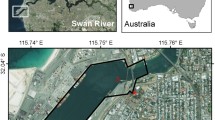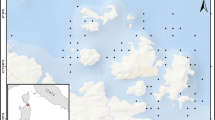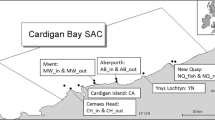Abstract
Coastal areas, and thus coastal species, are at increasing risk from human activities. Sections of the coastline of Western Australia are undergoing intense coastal development to fulfil commercial, industrial, and recreational requirements. Multiple populations of bottlenose dolphins (Tursiops aduncus) occur around this coastline; however, small community sizes and limited genetic exchange rates make them susceptible to anthropogenic pressure. This study investigated the occupancy of dolphins within the Swan–Canning Rivers, an urbanised estuary, with regard to (1) presence/absence, (2) abundance, and (3) duration in terms of time spent in the area. These response variables were related back to environmental conditions (tidal state, tidal height, salinity, temperature), vessel traffic, and dredging activities using generalised additive modelling. Theodolite tracking data revealed high levels of boat traffic at the two sites considered; however, dolphin occurrence was only negatively affected by vessel density at one of these sites. Dolphin occupancy was also significantly influenced by temperature, with possible seasonal effects. No dolphins were sighted on days when backhoe dredging was present; however, low sample sizes limited statistical interpretation. These results highlight the need to consider context in behavioural response studies, in terms of habitat type studied, explanatory variables considered, and response variables selected.
Similar content being viewed by others
References
Allen, S. J., D. D. Cagnazzi, A. J. Hodgson, N. R. Loneragan & L. Bejder, 2012. Tropical inshore dolphins of north-western Australia: unknown populations in a rapidly changing region. Pacific Conservation Biology 18: 56–63.
Anderwald, P., A. Brandecker, M. Coleman, C. Collins, H. Denniston, M. Haberlin, M. O’Donovan, R. Pinfield, F. Visser & L. Walshe, 2013. Displacement responses of a mysticete, an odontocete, and a phocid seal to construction-related vessel traffic. Endangered Species Research 21: 231–240.
Barton, K., 2016. MuMIn: Multi-Model Inference. http://cran.r-project.org/package=MuMIn.
Beidatsch, K., 2012. Machine Learning for Species Distribution Modelling: Evaluation of a Novel Method. Curtin University Honours Thesis.
Bejder, L., A. Samuels, H. Whitehead, N. Gales, J. Mann, R. Connor, M. Heithaus, J. Watson-Capps, C. Flaherty & M. Krutzen, 2006. Decline in relative abundance of bottlenose dolphins exposed to long-term disturbance. Conservation Biology 20: 1791–1798.
Buckstaff, K., 2004. Effects of watercraft noise on the acoustic behavior of bottlenose dolphins, Tursiops truncatus, in Sarasota Bay, Florida. Marine Mammal Science 20: 709–725.
Burnham, K. P. & D. R. Anderson, 2004. Multimodel inference: understanding AIC and BIC in model selection. Sociological Methods Research 33: 261–304.
Chabanne, D., H. Finn, C. Salgado-Kent & L. Bedjer, 2012. Identification of a resident community of bottlenose dolphins (Tursiops aduncus) in the Swan Canning Riverpark, Western Australia, using behavioural information. Pacific Conservation Biology 18: 247–262.
Christiansen, F., D. Lusseau, E. Stensland & P. Berggren, 2010. Effects of tourist boats on the behaviour of Indo-Pacific bottlenose dolphins off the south coast of Zanzibar. Endangered Species Research 11: 91–99.
Clark, C. W., W. T. Ellison, B. L. Southall, L. Hatch, S. M. Van Parijs, A. Frankel & D. Ponirakis, 2009. Acoustic masking in marine ecosystems: intuitions, analysis, and implication. Marine Ecology Progress Series 395: 201–222.
Clark, R. B., 2001. Marine Pollution. Oxford University Press, Oxford.
Constantine, R., D. H. Brunton & T. Dennis, 2004. Dolphin-watching tour boats change bottlenose dolphin (Tursiops truncatus) behaviour. Biological Conservation 117: 299–307.
Cosens, S., & L. Dueck, 1988. Responses of migrating narwhal and beluga to icebreaker traffic at the Admiralty Inled ice-edge, NWT in 1986 In Sackinger, W., & M. Jeffries (eds), Port and Ocean Engineering Under Arctic Conditions: 39–54.
DeMaster, D. P., C. W. Fowler, S. L. Perry & M. F. Richlen, 2001. Predation and competition: the impact of fisheries on marine mammal populations over the next one hundred years. Journal of Mammalogy 82: 641–651.
Diederichs, A., M. J. Brandt & G. Nehls, 2010. Does sand extraction near Sylt affect harbour porpoises? Wadden Sea Ecosystem 26: 199–203.
Durban, J. W., K. M. Parsons, D. E. Balcomb & K. C. Claridge, 2000. Quantifying dolphin occupancy patterns. Marine Mammal Science 16: 825–828.
Efford, M. G. & D. K. Dawson, 2012. Occupancy in continuous habitat. Ecosphere 3: art32.
Erbe, C., 2002. Hearing Abilities of Baleen Whales. DRDC Atlantic CR 2002-065.
Finn, H., 2005. Conservation biology of bottlenose dolphins (Tursiops sp.) in Perth metropolitan waters. Murdoch University PhD Thesis.
Fox, J. & S. Weisberg, 2011. An R Companion to Applied Regression. Sage, Thousand Oaks, CA.
Frid, A. & L. Dill, 2002. Human-caused disturbance stimuli as a form of predation risk. Ecology and Society 6: 11–26.
Guerra, M., S. M. Dawson, T. E. Brough & W. J. Rayment, 2014. Effects of boats on the surface and acoustic behaviour of an endangered population of bottlenose dolphins. Endangered Species Research 24: 221–236.
Hamilton, D. P., T. Chan, M. S. Robb, C. B. Pattiaratchi & M. Herzfeld, 2001. The hydrology of the upper Swan River Estuary with focus on an artificial destratification trial. Hydrological Processes 15: 2465–2480.
Hastie, G. D., B. Wilson, L. H. Tufft & P. M. Thompson, 2003. Bottlenose dolphins increase breathing synchrony in response to boat traffic. Marine Mammal Science 19: 74–84.
Hastie, G. D., B. Wilson, L. J. Wilson, K. M. Parsons & P. M. Thompson, 2004. Functional mechanisms underlying cetacean distribution patterns: hotspots for bottlenose dolphins are linked to foraging. Marine Biology 144: 397–403.
Heiler, J., S. H. Elwen, H. J. Kriesell & T. Gridley, 2016. Changes in bottlenose dolphin whistle parameters related to vessel presence, surface behaviour and group composition. Animal Behaviour 117: 167–177.
Heithaus, M. R. & L. M. Dill, 2002. Food availability and tiger shark predation risk influence bottlenose dolphin habitat use. Ecology 83: 480–491.
Hodgkin, E. P. & P. Hesp, 1998. Estuaries to salt lakes: holocene transformation of the estuarine ecosystems of south-western Australia. Marine and Freshwater Research 49: 183–201.
Holyoake, C., H. Finn, N. Stephens, P. Duignan, C. Salgado, H. Smith, L. Bejder, T. Linke, C. Daniel, H. N. Lo, G. S. Ham, K. Moiler, S. Allen, K. Bryant, & D. McElligott, 2010. Technical Report on the Bottlenose Dolphin (Tursiops aduncus) Unusual Mortality Event within the Swan Canning Riverpark, June–October 2009.
Ingram, S. N. & E. Rogan, 2002. Identifying critical areas and habitat preferences of bottlenose dolphins Tursiops truncatus. Marine Ecology Progress Series 244: 247–255.
Jensen, F. H., L. Bejder, M. Wahlberg, N. A. Soto, M. Johnson & P. T. Madsen, 2009. Vessel noise effects on delphinid communication. Marine Ecology Progress Series 395: 161–175.
Kurup, G. R., D. P. Hamilton & J. C. Patterson, 1998. Modelling the effect of seasonal flow variations on the position of salt wedge in a microtidal estuary. Estuarine, Coastal and Shelf Science 47: 191–208.
Latif, Q. S., M. M. Ellis & C. L. Amundson, 2016. A broader definition of occupancy: comment on Hayes and Monfils. Journal of Wildlife Management 80: 192–194.
Lele, S. R., E. H. Merrill, J. Keim & M. S. Boyce, 2013. Selection, use, choice and occupancy: clarifying concepts in resource selection studies. Journal of Animal Ecology 82: 1183–1191.
Linden, A. & S. Mantyniemi, 2011. Using the negative binomial distribution to model overdispersion in ecological count data. Ecology 92: 1414–1421.
Lusseau, D., 2003a. Effects of tour boats on the behavior of bottlenose dolphins: using Markov Chains to model anthropogenic impacts. Conservation Biology 17: 1785–1793.
Lusseau, D., 2003b. Male and female bottlenose dolphins Tursiops spp. have different strategies to avoid interactions with tour boats in Doubtful Sound, New Zealand. Marine Ecology Progress Series 257: 267–274.
Lusseau, D., 2005. Residency pattern of bottlenose dolphins Tursiops spp. in Milford Sound, New Zealand, is related to boat traffic. Marine Ecology Progress Series 295: 265–272.
Lusseau, D., 2006. The short-term behavioral reactions of Bottlenose dolphins to interactions with boats in doubtful sound, New Zealand. Marine Mammal Science 22: 802–818.
Lusseau, D. & J. E. S. Higham, 2004. Managing the impacts of dolphin-based tourism through the definition of critical habitats: the case of bottlenose dolphins (Tursiops spp.) in Doubtful Sound, New Zealand. Tourism Management 25: 657–667.
MacKenzie, D. I. & J. D. Nichols, 2004. Occupancy as a surrogate for abundance estimation. Animal Biodiversity and Conservation 27: 461–467.
Marley, S. A., C. Erbe & C. P. Salgado-Kent, 2016. Underwater sound in an urban estuarine river: sound sources, soundscape contribution, and temporal variability. Acoustics Australia 44: 171–186.
May-Collado, L. J. & S. G. Quiñones-Lebrón, 2014. Dolphin changes in whistle structure with watercraft activity depends on their behavioral state. The Journal of the Acoustical Society of America 135: 193–198.
McIntyre, A. D., 1999. Conservation in the sea – looking ahead. Aquatic Conservation: Marine and Freshwater Ecosystems 9: 633–637.
Moiler, K., 2008. Bottlenose Dolphins (Tursiops sp.) – A Study of Patterns in Spatial and Temporal use of the Swan River, Western Australia. Curtin University Honours Thesis.
Moore, P. G., 1999. Fisheries exploitation and marine habitat conservation: a strategy for rational coexistence. Aquatic Conservation: Marine and Freshwater Ecosystems 9: 585–591.
Morisaka, T., M. Shinohara, F. Nakahara & T. Akamatsu, 2005. Effects of ambient noise on the whistles of Indo-Pacific bottlenose dolphin populations. Journal of Mammalogy 86: 541–546.
Morton, A. & K. Symonds, 2002. Displacement of Orcinus orca (L.) by high amplitude sound in British Columbia, Canada. ICES Journal of Marine Science 59: 71–80.
Nowacek, D. P., L. H. Thorne, D. W. Johnston & P. L. Tyack, 2007. Responses of cetaceans to anthropogenic noise. Mammal Review 37: 81–115.
O’Hara, R. B. & D. J. Kotze, 2010. Do not log-transform count data. Methods in Ecology and Evolution 1: 118–122.
Paiva, E. G., C. P. Salgado Kent, M. M. Gagnon, R. McCauley & H. Finn, 2015. Reduced detection of Indo-Pacific bottlenose dolphins (Tursiops aduncus) in an inner harbour channel during pile driving activities. Aquatic Mammals 41: 455–468.
Pearson, M., 2007. Reeds Skipper’s Handbook. Adlard Coles Nautical, London.
Pirotta, E., B. E. Laesser, A. Hardaker, N. Riddoch, M. Marcoux & D. Lusseau, 2013. Dredging displaces bottlenose dolphins from an urbanised foraging patch. Marine Pollution Bulletin 74: 396–402.
Pirotta, E., N. D. Merchant, P. M. Thompson, T. R. Barton & D. Lusseau, 2015. Quantifying the effect of boat disturbance on bottlenose dolphin foraging activity. Biological Conservation 181: 82–89.
R Core Team, 2015. R: A language and environment for statistical computing. R Foundation for Statistical Computing, Vienna.
Richards, S. A., 2008. Dealing with overdispersed count data in applied ecology. Journal of Applied Ecology 45: 218–227.
Richards, S. A., M. J. Whittingham & P. A. Stephens, 2011. Model selection and model averaging in behavioural ecology: the utility of the IT-AIC framework. Behavioral Ecology and Sociobiology 65: 77–89.
Richardson, W. J., R. A. Davis, C. R. Evans, D. K. Ljungblad & P. Norton, 1987. Summer distribution of Bowhead Whales, Balaena rnysticetus, Relative to Oil Industry Activities in the Canadian Beaufort Sea, 1980-84. Arctic 40: 93–104.
Richardson, W. J., B. Würsig, M. A. Fraker & R. S. Wells, 1985. Behaviour of bowhead whales, Balaena mysticetus, summering in the Beaufort Sea: reactions to industrail activities. Biological Conservation 32: 195–230.
Richardson, W. J., B. Wursig & C. R. Greene, 1990. Reactions of bowhead whales, Balaena mysticetus, to drilling and dredging noise in the canadian Beaufort sea. Marine Environmental Research 29: 135–160.
Robson, B. J., P. A. Bukaveckas & D. P. Hamilton, 2008. Modelling and mass balance assessments of nutrient retention in a seasonally-flowing estuary (Swan River Estuary, Western Australia). Estuarine, Coastal and Shelf Science 76: 282–292.
Ross, G. J. B., 2006. Review of the Conservation Status of Australia’s Smaller Whales and Dolphins. Australian Government.
Salgado Kent, C., R. D. McCauley, I. M. Parnum, & A. N. Gavrilov, 2012. Underwater noise sources in Fremantle Inner Harbour: dolphins, pile driving and traffic. Proceedings of the Acoustical Society of Australia: Fremantle, Western Australia; 21–23 November.
Sarkar, D., 2008. Lattice: Multivariate Data Visualization with R. Springer, New York.
Shane, S. H., 1990. Comparison of bottlenose dolphin behavior in Texas and Florida, with a critique of methods for studying dolphin behavior. In Leatherwood, S. & R. R. Reeves (eds), The Bottlenose Dolphin. Academic Press, San Diego: 541–558.
Steckenreuter, A., L. Möller & R. Harcourt, 2012. How does Australia’s largest dolphin-watching industry affect the behaviour of a small and resident population of Indo-Pacific bottlenose dolphins? Journal of Environmental Management 97: 14–21.
Swan River Trust, 2015. Dolphin Watch Annual Report. http://www.riverguardians.com/projects/dolphin-watch/dolphin-research.
Thompson, P. M., B. Wilson, K. Grellier & P. S. Hammond, 2000. Combining power analysis and population viability analysis to compare traditional and precautionary approaches to conservation of coastal cetaceans. Conservation Biology 14: 1253–1263.
Thomsen, C. E., T. Rose, & M. Robb, 2001. Seasonal water quality patterns in the Swan River Estuary, 1994–1998, technical report. Swan River Trust, Western Australia
Todd, V. L. G., I. B. Todd, J. C. Gardiner, E. C. N. Morrin, N. A. Macpherson, N. A. Dimarzio & F. Thomsen, 2015. A review of impacts of marine dredging activities on marine mammals. ICES Journal of Marine Science 72: 328–340.
Tyack, P. L., 2008. Large-scale changes in the marine acoustic environment. Journal of Mammalogy 89: 549–558.
Venables, W. N. & B. D. Ripley, 2002. Modern Applied Statistics with S. Springer, New York.
Waples, D. M., L. H. Thorne, L. E. W. Hodge, E. K. Burke, K. W. Urian & A. J. Read, 2013. A field test of acoustic deterrent devices used to reduce interactions between bottlenose dolphins and a coastal gillnet fishery. Biological Conservation 157: 163–171.
Weilgart, L. S., 2007. The impacts of anthropogenic ocean noise on cetaceans and implications for management. Canadian Journal of Zoology 85: 1091–1116.
Williams, R., A. W. Trites & D. E. Bain, 2002. Behavioural responses of killer whales (Orcinus orca) to whale-watching boats: opportunistic observations and experimental approaches. Journal of Zoology 256: 255–270.
Wilson, B., P. S. Hammond & P. M. Thompson, 1999. Estimating size and assessing trends in a coastal bottlenose dolphin population. Ecological Applications 9: 288–300.
Wood, S. N., 2006. Generalized Additive Models: An Introduction with R. Chapman and Hall/CRC, Boca Raton.
Zuur, A. F. & E. N. Ieno, 2016. A protocol for conducting and presenting results of regression-type analyses. Methods in Ecology and Evolution 7: 636–645.
Zuur, A. F., E. N. Ieno & C. S. Elphick, 2010. A protocol for data exploration to avoid common statistical problems. Methods in Ecology and Evolution 1: 3–14.
Zuur, A., E. N. Ieno, N. Walker, A. A. Saveliev & G. S. Smith, 2009. Mixed effects models and extensions in ecology with R. Springer, New York.
Acknowledgements
The authors would like to thank the Department of Spatial Sciences at Curtin University for generous use of their theodolite, and Eric Kniest (University of Newcastle) for support during theodolite and Vadar software set-up. Fremantle Council and the Botanic Gardens and Parks Authority (BGPA) of Kings Park kindly allowed access to their sites for data collection, with Jake Tanner going above-and-beyond to provide assistance in accessing Cantonment Hill. This study had extraordinary support from over 60 volunteer observers, without whom data collection would not have been possible. Of these, special thanks go to Phillippa Adamson, Mariana Barbosa, Jordan Claytor, Ana Costa, Shannon Dee, Caroline Delaisse, David Grose, Robin Hare, Adam Koziol, Jacob Noonan, Tamar Orly, Lucy Rudd, Charlotte Tecknenoff, Alessandra Wasserman, and Katie Werndly. Thanks also go to Angela Recalde Salas and Phil Bouchet for assistance in field site set-up and helpful statistical discussions. Finally, we would like to thank the Swan River Trust for continuing support of dolphin research in the Swan-Canning Rivers.
Author information
Authors and Affiliations
Corresponding author
Additional information
Handling editor: Iacopo Bertocci
Rights and permissions
About this article
Cite this article
Marley, S.A., Salgado Kent, C.P. & Erbe, C. Occupancy of bottlenose dolphins (Tursiops aduncus) in relation to vessel traffic, dredging, and environmental variables within a highly urbanised estuary. Hydrobiologia 792, 243–263 (2017). https://doi.org/10.1007/s10750-016-3061-7
Received:
Revised:
Accepted:
Published:
Issue Date:
DOI: https://doi.org/10.1007/s10750-016-3061-7












